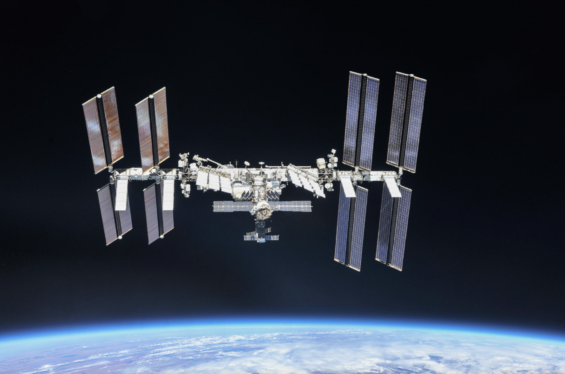
As NASA plans missions to the Moon and Mars, a key factor is figuring out how to feed crew members during their weeks, months, and even years in space.
Astronauts on the International Space Station primarily eat prepackaged food, which requires regular resupply and can degrade in quality and nutrition. Researchers are exploring the idea of crews growing some of their food during a mission, testing various crops and equipment to figure out how to do this without a lot of extra hardware or power.
Picking the right plants
The first step in this research is identifying which plants to test. NASA started a project in 2015 with the Fairchild Botanical Garden in Miami called “Growing Beyond Earth.” The program has recruited hundreds of middle and high school science classes across the U.S. to grow different seeds in a habitat similar to one on the space station. Seeds that grow well in the classrooms are then tested in a chamber at NASA’s Kennedy Space Center. Ones that do well there are sent to the station to test how they grow in microgravity.
Gardens in space
NASA also has tested facilities to host future microgravity gardens. One is the Vegetable Production System, or Veggie, a simple, low-power chamber that can hold six plants. Seeds are grown in small fabric “pillows” that crew members look after and water by hand, similar to caring for a window garden on Earth.
Another system, the Passive Orbital Nutrient Delivery System, or Veggie PONDS, works with the Veggie platform but replaces seed pillows with a holder that automatically feeds and waters the plants. The Advanced Plant Habitat is a fully automated device designed to study growing plants in ways that require only minimal crew attention.

The right light and food
A series of experiments aboard the space station known as Veg-04A, Veg-04B, and Veg-05 grew Mizuna mustard, a leafy green crop, under different light conditions and compared plant yield, nutritional composition, and microbial levels. The investigation also compared the space-grown plants to ones grown on Earth, and had crew members rate the flavor, texture, and other characteristics of the produce.
Plant Habitat-04 analyzed plant-microbe interactions and assessed the flavor and texture of chile peppers. The first crop, harvested on Oct. 29, 2021, was eaten by the crew and 12 peppers from the second harvest were returned to Earth for analysis. This experiment demonstrated that research about space crop production is on the right path and researchers plan to apply lessons learned to testing other plants.

The influence of gravity
An early experiment, PESTO, found that microgravity alters leaf development, plant cells, and the chloroplasts used in photosynthesis, but did not harm the plants overall. In fact, wheat plants grew 10% taller compared to those on Earth.
The Seedling Growth investigations showed that seedlings can acclimate to microgravity by modulating expression of some genes related to the stressors of space, a discovery that adds to knowledge about how microgravity affects plant physiology [1].
One way that plants sense gravity is via changes to calcium within their cells. Plant Gravity Sensing, a JAXA (Japan Aerospace Exploration Agency) investigation, measured how microgravity affects calcium levels, which could help scientists design better ways to grow food in space.
ADVASC, an investigation that grew two generations of mustard plants using the Advanced Astroculture chamber, showed that seeds were smaller but germination rates near normal in microgravity [2].

Water delivery
One significant challenge for growing plants in microgravity is providing enough water to keep them healthy without drowning them in too much water. Plant Water Management demonstrated a hydroponic (water-based) method for providing water and air to plant roots. The XROOTS study tested using both hydroponic and aeroponic (air-based) techniques to grow plants rather than traditional soil. These techniques could enable large-scale crop production for future space exploration.

Transplanting veggies
During a series of investigations called VEG-03, which cultivated Extra Dwarf Pak Choi, Amara Mustard, and Red Romaine Lettuce, NASA astronaut Mike Hopkins noticed some of the plants were struggling. Hopkins conducted the first plant transplant in space, moving extra sprouts from thriving plant pillows into two of the struggling pillows in Veggie. The transplants survived and grew, opening new possibilities for future plant growth.
Plant genetics
Plants exposed to spaceflight undergo changes that involve the addition of extra information to their DNA, affecting how genes turn on or off without changing the sequence of the DNA itself. This process is known as epigenetic change. Plant Habitat-03 assesses whether such adaptations in one generation of plants grown in space can transfer to the next generation.
The long-term goal is to understand how epigenetics contribute to adaptive strategies that plants use in space and, ultimately, develop plants better suited for providing food and other services on future missions. Results also could support the development of strategies for adapting crops and other economically important plants for growth in marginal and reclaimed habitats on Earth.
The human effect
Gardens need tending, of course. The Veg-04A, Veg-04B, and Veg-05 investigations also looked at how tending plants contributed to the well-being of astronauts. Many astronauts reported they found caring for plants an enjoyable and relaxing activity – another important contribution to future long-duration missions.

Citations:
1 Medina F, Manzano A, Herranz R, Kiss JZ. Red Light Enhances Plant Adaptation to Spaceflight and Mars g-Levels. Life. 2022, 12(10), 1484; https://doi.org/10.3390/life12101484
2 Link BM, Busse JS, Stankovic B. Seed-to-Seed-to-Seed Growth and Development of Arabidopsis in Microgravity. Astrobiology. 2014 October; 14(10): 866-875. DOI: 10.1089/ast.2014.1184.PMID: 25317938





